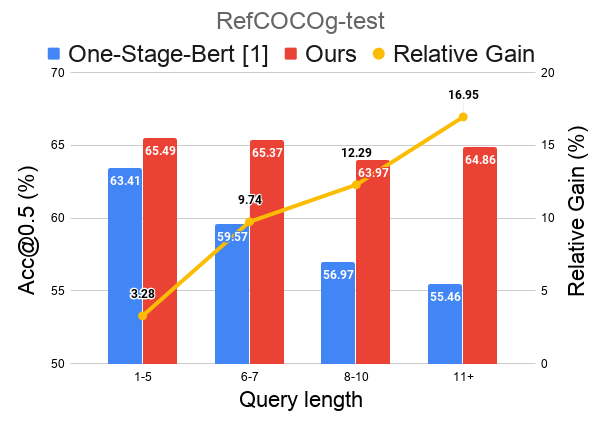# ReSC
**Repository Path**: tujun233/ReSC
## Basic Information
- **Project Name**: ReSC
- **Description**: No description available
- **Primary Language**: Unknown
- **License**: MIT
- **Default Branch**: master
- **Homepage**: None
- **GVP Project**: No
## Statistics
- **Stars**: 0
- **Forks**: 0
- **Created**: 2023-12-06
- **Last Updated**: 2023-12-06
## Categories & Tags
**Categories**: Uncategorized
**Tags**: None
## README
# Improving One-stage Visual Grounding by Recursive Sub-query Construction
[Improving One-stage Visual Grounding by Recursive Sub-query Construction](https://arxiv.org/pdf/2008.01059.pdf)
by [Zhengyuan Yang](http://cs.rochester.edu/u/zyang39/), [Tianlang Chen](http://cs.rochester.edu/u/tchen45/), [Liwei Wang](http://www.deepcv.net/), and [Jiebo Luo](http://cs.rochester.edu/u/jluo)
European Conference on Computer Vision (ECCV), 2020
### Introduction
We propose a recursive sub-query construction framework to address previous one-stage visual grounding methods' limitations on grounding long and complex queries. For more details, please refer to our [paper](https://arxiv.org/pdf/2008.01059.pdf).

[1] Yang, Zhengyuan, et al. ["A fast and accurate one-stage approach to visual grounding"](https://arxiv.org/pdf/1908.06354.pdf). ICCV 2019.
### Prerequisites
* Python 3.6 (3.5 tested)
* Pytorch 0.4.1 and 1.4.0 tested (other versions in between should work)
* Others ([Pytorch-Bert](https://pypi.org/project/pytorch-pretrained-bert/), etc.) Check requirements.txt for reference.
## Installation
1. Clone the repository
```
git clone https://github.com/zyang-ur/ReSC.git
```
2. Prepare the submodules and associated data
* RefCOCO, RefCOCO+, RefCOCOg, ReferItGame Dataset: place the data or the soft link of dataset folder under ``./ln_data/``. We follow dataset structure [DMS](https://github.com/BCV-Uniandes/DMS). To accomplish this, the ``download_dataset.sh`` [bash script](https://github.com/BCV-Uniandes/DMS/blob/master/download_data.sh) from DMS can be used.
```bash
bash ln_data/download_data.sh --path ./ln_data
```
* Data index: download the generated index files and place them as the ``./data`` folder. Availble at [[Gdrive]](https://drive.google.com/file/d/1fVwdDvXNbH8uuq_pHD_o5HI7yqeuz0yS/view?usp=sharing), [One Drive].
```
rm -r data
tar xf data.tar
```
* Model weights: download the pretrained model of [Yolov3](https://pjreddie.com/media/files/yolov3.weights) and place the file in ``./saved_models``.
```
sh saved_models/yolov3_weights.sh
```
More pretrained models are availble in the performance table [[Gdrive]](https://drive.google.com/drive/folders/1L2GUOUmhBDLA3WgaXfzLoNhJFf609vCe?usp=sharing), [One Drive] and should also be placed in ``./saved_models``.
### Training
3. Train the model, run the code under main folder.
Using flag ``--large`` to access the ReSC-large model. ReSC-base is the default.
```
python train.py --data_root ./ln_data/ --dataset referit \
--gpu gpu_id --resume saved_models/ReSC_base_referit.pth.tar
```
4. Evaluate the model, run the code under main folder.
Using flag ``--test`` to access test mode.
```
python train.py --data_root ./ln_data/ --dataset referit \
--gpu gpu_id --resume saved_models/ReSC_base_referit.pth.tar --test
```
### Implementation Details
We train 100 epoches with batch size 8 on all datasets expect RefCOCOg, where we find training 20/40 epoches have the best performance. We fix the bert weights during training as the default. The language encoder can be finetuned with the flag ``--tunebert``. We observe a small improvenment on some datasets (e.g. RefCOCOg). Please check other experiment settings in our [paper](https://arxiv.org/pdf/2008.01059.pdf).
## Performance and Pre-trained Models
Pre-trained models are availble in [[Gdrive]](https://drive.google.com/drive/folders/1L2GUOUmhBDLA3WgaXfzLoNhJFf609vCe?usp=sharing), [One Drive].
| Dataset |
Ours-base (Acc@0.5) |
Ours-large (Acc@0.5) |
| RefCOCO |
val: 76.74 |
val: 78.09 |
| testA: 78.61 |
testA: 80.89 |
| testB: 71.85 |
testB: 72.97 |
| RefCOCO+ |
val: 63.21 |
val: 62.97 |
| testA: 65.94 |
testA: 67.13 |
| testB: 56.08 |
testB: 55.43 |
| RefCOCOg |
val-g: 61.12 |
val-g: 62.22 |
| val-umd: 64.89 |
val-umd: 67.50 |
| test-umd: 64.01 |
test-umd: 66.55 |
| ReferItGame |
val: 66.78 |
val: 67.15 |
| test: 64.33 |
test: 64.70 |
### Citation
@inproceedings{yang2020improving,
title={Improving One-stage Visual Grounding by Recursive Sub-query Construction},
author={Yang, Zhengyuan and Chen, Tianlang and Wang, Liwei and Luo, Jiebo},
booktitle={ECCV},
year={2020}
}
@inproceedings{yang2019fast,
title={A Fast and Accurate One-Stage Approach to Visual Grounding},
author={Yang, Zhengyuan and Gong, Boqing and Wang, Liwei and Huang
, Wenbing and Yu, Dong and Luo, Jiebo},
booktitle={ICCV},
year={2019}
}
### Credits
Our code is built on [Onestage-VG](https://github.com/zyang-ur/onestage_grounding).
Part of the code or models are from
[DMS](https://github.com/BCV-Uniandes/DMS),
[film](https://github.com/ethanjperez/film),
[MAttNet](https://github.com/lichengunc/MAttNet),
[Yolov3](https://pjreddie.com/darknet/yolo/) and
[Pytorch-yolov3](https://github.com/eriklindernoren/PyTorch-YOLOv3).
